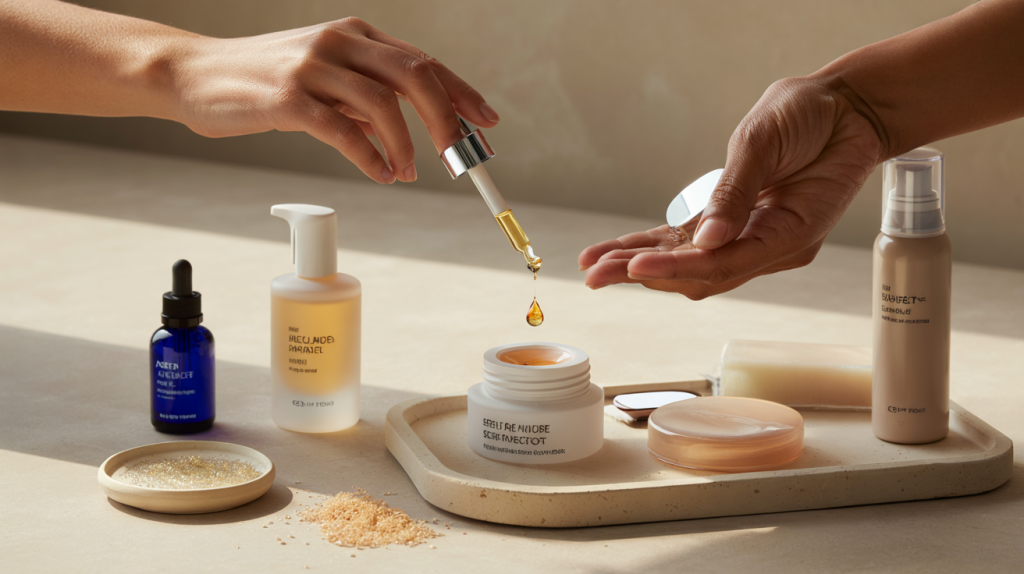Beauty trends 2025 that matter right now
New year, new playbook. Beauty in 2025 rewards smart choices that save time, look natural and still deliver high performance. Think skin barrier care with peptides and retinaldehyde, tint-serums that blur and protect, bond-building hair care that actually strengthens, and fragrances that sit closer to skin for everyday wear.
The market context points in one direction. According to McKinsey’s 2023 report, beauty reached about 430 billion dollars in 2022 and could grow around 6 percent per year to roughly 580 billion dollars by 2027. Circana reported prestige beauty sales in the United States up 15 percent in 2023. L’Oréal posted 41.18 billion euros in sales in 2023. Demand has stayed strong, yet formulas, formats and claims now face tougher questions, including new EU rules on microplastics that reshape how products land in 2025.
Performance first: skincare, makeup and haircare get smarter
Consumers want visible results without 10 steps. That is why 2025 leans into streamlined routines and hybrid textures. One product does two jobs, sometimes three. A peptide moisturizer supports the barrier and pairs with retinaldehyde two nights a week for smoother texture. A tint-serum evens tone and adds SPF for daily city life. Less clutter, more payoff.
Makeup follows the same logic. Skin-revealing foundations, soft matte finishes that flex with humidity, lip oils that cushion without stickiness. The win is comfort that photographs well, not mask-like coverage. It reads fresh on camera and in daylight, which suits hybrid work and quick commutes.
Hair has borrowed from skincare. Bond builders and ceramide-rich masks focus on strength, not just shine. Heat protection sits front and center. Air-dry creams return on busy mornings, because time and energy costs weigh on daily choices.
Clean beauty in 2025: what the EU microplastics rules change
Formulas and glitters face a new line in the sand. Regulation (EU) 2023/2055, adopted on 25 September 2023, restricts microplastics intentionally added to products, including cosmetics, with phased deadlines. Brands have been reformulating eye and body glitters, scrubs and some film-formers to meet the calendar, which continues to roll through the mid 2020s.
What does that mean for a makeup bag. Expect fewer loose plastic glitters and more biodegradable alternatives. Scrubs use powders from cellulose or silica rather than traditional beads. Longwear claims remain, yet chemists pivot to different polymer systems and wax blends that rinse cleaner.
Labels evolve too. Phrases like “microplastic free” need precision. Read ingredient lists and look for brand notes on EU compliance for 2025 batches. Retailers update filters to reflect the regulation, easing comparisons across products.
AI beauty tools go practical: shade matching and at home diagnostics
AI moved from hype to utility. Shade-match engines scan skin under different lighting and cut guesswork for foundation or concealer. That means fewer returns and a smoother routine for sensitive or acne prone skin that dislikes trial and error.
Diagnostics also help with timing. Apps track exfoliation nights, retinoid spacing and UV index to suggest when to reach for a soothing serum instead of another active. The idea is simple. Technology supports consistency and helps avoid irritation spikes that derail progress.
Innovation keeps widening access as well. L’Oréal showcased assistive beauty devices such as HAPTA at CES 2023, signaling a continued push into tools that stabilize application for users with limited mobility. Expect more inclusive hardware and software in 2025 launches.
Sustainable packaging and refills: easy wins that still look good
Refills have matured. Cases feel premium and pumps reduce parts, often moving toward mono materials so recycling gets easier at curbside. Glass jars and aluminum bottles return, while travel sizes help test before committing to full formats and cut waste.
The most effective choices stay practical in daily life. A refillable moisturizer used to the last drop saves money and plastic across the year. Solid shampoos make sense for gym bags and flights, yet liquids remain for textured or color treated hair that needs slip. The point is to choose what fits reality, then stick to it.
Market signals support these shifts. Growth in prestige beauty through 2023, cited by Circana in 2024, encouraged brands to scale refill programs and improve logistics for faster replenishment. With the EU microplastics timetable in motion since 2023, packaging and formula roadmaps align more tightly than in past cycles.
Here is a concise, practical shortlist to build a 2025 routine without clutter.
- Pick one active night routine: alternate a gentle retinoid with a peptide or ceramide cream to protect the barrier.
- Use a tint serum with SPF on weekdays and add targeted concealer only where needed.
- Choose one bond builder for hair and limit heat to lower settings, then finish with a light serum.
- Switch one daily product to a refill format and track the refill cadence in your phone.
Next steps land smoothly. Check product pages for “EU 2023/2055 compliant” notes on new batches. Use retailer AI shade tools before buying a base. Sample sizes help confirm texture and scent in real life lighting. If a product triggers redness, pause actives for three nights and go back to a simple moisturizer, then reintroduce slowly to recieve the benefits without setbacks.
Data backs the momentum. McKinsey’s 2023 growth outlook sets the pace into 2027, while L’Oréal’s 2023 revenue underlines the capacity to scale new tech and greener packaging. For 2025, that mix of performance, clarity on rules and timely tools is what turns trends into a routine that actually works.
